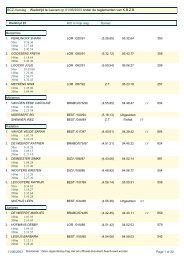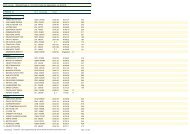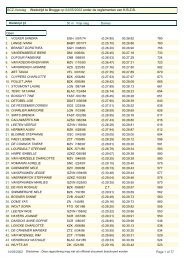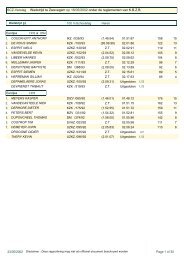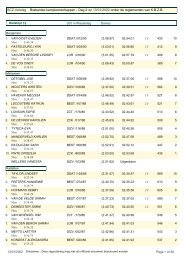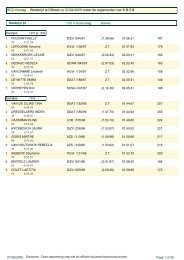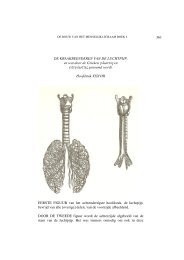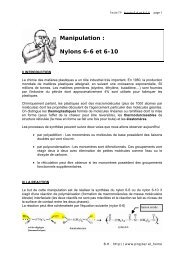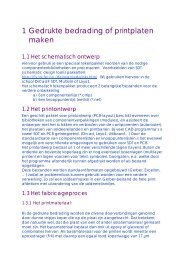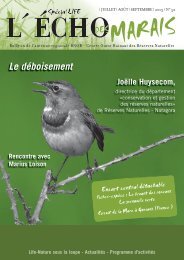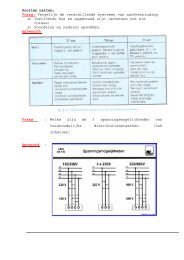Vesaliana
Vesaliana
Vesaliana
You also want an ePaper? Increase the reach of your titles
YUMPU automatically turns print PDFs into web optimized ePapers that Google loves.
M. BIESBROUCK. VESALIUS BIBLIOGRAPHY: UPDATE JANUARY 2013<br />
303 * CARMAN John Burd. ‘Anatomist’s preface’ in William Frank RICHARDSON, John<br />
Burd CARMAN, Andreas Vesalius: on the Fabric of the Human Body. A<br />
Translation of ‘De Humani Corporis Fabrica Libri Septem’. Vol. II: Book II, The<br />
Ligaments and Muscles, San Francisco, Norman Publishing, 1999, pp. xvii-xxiv.<br />
On Vesalius’ organisation of his descriptions (p. xvii-xviii), his insight in muscle<br />
physiology (p. xix), on the muscle plates and the landscapes (p. xix-xx), the artists (p; xxi),<br />
the cooperation between translator and anatomist (p; xxi), his conflictual views with Galen<br />
(p; xxii) and Vesalius as an expert dissector.<br />
304 * CARMAN John Burd. ‘Anatomist’s preface’ in William Frank RICHARDSON, John<br />
Burd CARMAN, Andreas Vesalius: on the Fabric of the Human Body. A<br />
Translation of ‘De Humani Corporis Fabrica Libri Septem’. Vol. III: Book III, The<br />
veines and arteries, Book IV, The nerves, Novato, California, Norman Publishing,<br />
2002, pp. xvii-xxvi.<br />
On the rete mirabile, the difficulty of dissection of the ‘vessels’, the differences with animal<br />
anatomy, difficulty to match Vesalius’ terminology to modern nomenclature, with other<br />
concepts and numberings. Also on individual anatomical variability. Comparison of some<br />
figures from the Fabrica with the more accurate ones of the Epitome.<br />
304.05 * CARMAN John Burd. ‘Preface’ in William Frank RICHARDSON, John Burd<br />
CARMAN, Andreas Vesalius: on the Fabric of the Human Body. A Translation of<br />
‘De Humani Corporis Fabrica Libri Septem’. Vol. IV: Book V, The Organs of<br />
Nutrition and Generation, Novato, California, Norman Publishing, 2007, pp. ixxiv.<br />
On Vesalius’ view of the peritoneum, the oesophagus (with the dissection of 14<br />
individuals), the appendix (or cecum), the liver, kidney and the reproductive organs with the<br />
tuba uterina (comparison with the Epitome). Comment on an error in the illustrations. On<br />
Vesalius’ account for the dissection of the abdomino-pelvic organs. Also about the<br />
contribution of W.R. Richardson to the English translation of the Fabrica.<br />
304.06 * CARMAN John Burd. ‘Preface’ in William Frank RICHARDSON, John Burd<br />
CARMAN, Andreas Vesalius: on the Fabric of the Human Body. A Translation of<br />
‘De Humani Corporis Fabrica Libri Septem’. Vol. V: Book VI, The Heart and<br />
Associated Organs, Book VII, The Brain, Novato, California, Norman Publishing,<br />
2009, pp. ix-xii.<br />
On Vesalius as an accomplished morphologist and on Will Richardson’s (+2005) translation<br />
work.<br />
305 * CARRE, M.H. ‘Illustration and the renaissance of science’ in Hibbert Journal, 63,<br />
1964-1965, no. 251, 156-159.<br />
Passim on the importance of the collaboration between artist and scientist in Vesalius’s<br />
Fabrica.<br />
305.50 * CARTER, John, Percy H. MUIR (eds.). ‘The Birth of Modern Anatomy: Andreas<br />
Vesalius (1514-1564)’ in Printing and the Mind of Man: Descriptive Catalogue<br />
Illustrating the Impact of Print on the Evolution of Western Civilisation during five<br />
Centuries, München, Karl Pressler, 1983, * 71, p. 43.<br />
First edition by Cassell and Company in 1967.<br />
-76-



